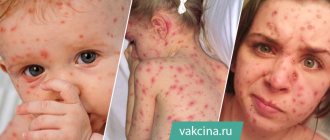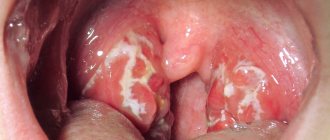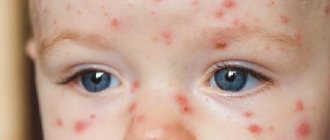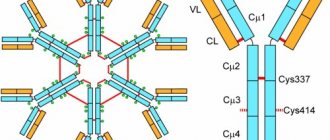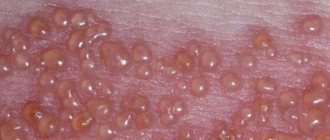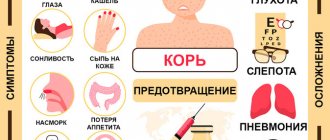Varicella (chickenpox) - symptoms and treatment
How long does chicken pox (chickenpox) last?
The incubation period lasts from 10 to 21 days. In typical cases (in children and adolescents), the disease begins acutely. On average, chickenpox lasts 7-10 days.
Symptoms of chickenpox in adults and children
Chickenpox in adults, due to the loss of lability of the immune system, manifests itself with a subacute and gradual onset (i.e., the main syndrome appears 2-3 or later days from the onset of the disease). Children, as a rule, tolerate the disease more easily.
Symptoms of chickenpox in children and adults:
- general infectious intoxication (SOII);
- vesicular exanthema;
- vesicular enanthema (aphthae);
- lymphadenopathy (LAP);
- persistent fever.
In typical cases, the height of the disease is preceded by a prodromal period lasting up to one day, mild, accompanied by slight weakness, low-grade fever, and rarely a small-spotted rash rash.
By the end of the first day, the height of the disease begins. The first symptoms of chickenpox include increasing intoxication, distinct weakness, and body temperature up to 38-39 ℃. During this period, the most characteristic sign that allows a correct diagnosis to be made is the appearance of a characteristic macular-vesicular rash. The first elements are localized on the scalp and behind the ears, then the rash spreads to the torso and limbs. It is typical that the face is affected later than other parts of the body. Elements of the rash appear in series with an interval of 12-48 hours, each new rash is accompanied by an increase in body temperature, new elements appear between the old ones and their number increases, which causes pronounced polymorphism of the rashes. As soon as the body temperature returns to normal, within 2-3 days we can talk about the healing process and the end of the period of rash.
The dynamics of the rash are very characteristic: first, a rounded reddish spot 5-10 mm in size appears, then a papule forms in the center, then a vesicle (bubble) with transparent contents up to 10 mm (single-chamber and collapsing upon puncture). Further, when secondary flora attaches, it may suppurate, after which it may dry out and form crusts, which fall off after 6-8 days, usually without subsequent defects. In rare cases (severe suppuration, scratching), scars may form.
Simultaneously with rashes on the skin, tender vesicles form on the oral mucosa, which, quickly opening, form aphthae (erosions) and can cause a feeling of discomfort and burning in the mouth.
Chicken pox in newborns
Infants rarely get chickenpox, since most of them are protected by maternal antibodies. If antibodies against the virus are passed on to the child from the mother, then the disease may be erased in a mild form. If there are no protective maternal antibodies, then chickenpox progresses rapidly: symptoms of intoxication are pronounced, convulsions are possible, consciousness is impaired, and complications arise from the internal organs and nervous system.
Chicken pox in pregnant women
Due to the wide spread of the disease, mainly in childhood and adolescence, by the time of pregnancy, women are in most cases immune to the chickenpox virus (i.e., if chickenpox was suffered before pregnancy, there is no risk of recurrence of the disease and no threat to the child; accordingly, there are no risks with contact of a pregnant woman with a patient with chickenpox or herpes zoster). In rare cases, when a pregnant woman does not have a titer of protective antibodies and comes into contact with a sick person, different outcomes are possible, depending on the stage of pregnancy. Acute chickenpox poses a significant danger to the pregnant woman herself (which is often forgotten by both the woman herself and the doctor who diagnosed the disease).
Formation of immunity
After the first reaction to the introduction of Varicella Zoster into the cells of the nervous system, the immune system begins to produce immunoglobulins. These are specific structures aimed at identifying and neutralizing various pathogens. Immunoglobulins destroy viruses and body cells that have been damaged by the action of the pathogen. After the infectious process in the body is stopped, most of the antibodies die. However, a small part of them mutate and become so-called memory cells. These are structures that allow the body to recognize Varicella Zoster and immediately destroy the virus if it begins to become active.
In some people, for a number of reasons, the immune system is completely unable to produce memory cells, or they die several months or years after having chickenpox. In this case, the patient may get chickenpox again if he encounters an infectious carrier of the virus.
Attention!
Science has not yet been able to establish for what reasons some people lose the memory cells responsible for developing immunity to chickenpox. In medical practice, there have been several cases where patients contracted chickenpox more than 3-4 times.
Disease prevention
Prevention includes isolating patients at home and introducing quarantine in children's institutions.
To avoid infection, people who have not been sick should avoid contact with sick people. There is also specific prevention of the disease. The chickenpox vaccine in children prevents the disease in 98% of patients who receive the two recommended injections. Vaccination is carried out at the age of 12 - 15 months, revaccination - at 4 - 6 years.
For older children and adults who have not been vaccinated, the chickenpox vaccine can be given at any time to help prevent the disease.
Is it possible to get chickenpox again?
In most cases, people who have had chickenpox once are no longer at risk of contracting this infection. However, in approximately 3-5% of cases, patients get it again. Relapse of the pathology occurs against the background of a depressed state of the immune system. The developed immunity to chickenpox is non-sterile. This means that after suffering from the disease, a person not only remains immune to chickenpox, but the virus itself continues to exist in the patient’s body. The causative agent is located in the spinal ganglia, that is, in the endings of nerve cells. In most cases, the virus remains inactive in cells and continues to exist for decades.
It is due to the fact that pathogens are located in the cells of the nervous tissue that the immune system continues to constantly produce antibodies to them. Re-infection with chickenpox is possible in two cases:
- The immune system produces an insufficient amount of antibodies, as a result of which the virus that has entered the body from the outside begins to actively multiply.
- Varicella Zoster is activated due to a sharp weakening of the human immune system. Elderly people are most susceptible to this.
Attention!
Cases of repeated chickenpox occur in adults in more than 80% of cases, but children can also become infected again. This indicates that the child’s immune system is suppressed due to some other, more severe pathology. In addition, symptoms similar to chickenpox can occur with a number of other diseases: scabies, allergies, dermatitis, etc.
Video - Is it possible to get chickenpox again?
And here it is - chickenpox...
First, the child complains of feeling unwell: suddenly he has a headache, body aches, and a sore throat. It is clear that he is unwell, but what kind of illness is still unclear. Then (a few hours later or the next day) the temperature rises, and a rash appears against its background. However, there may be no fever or symptoms preceding it, but there will definitely be a rash.
The elements of the rash have their own “life cycle”: small red spots turn into bumps resembling mosquito bites (papules), then liquid accumulates in them (such elements are called vesicles). The vesicles burst, and crusts appear in their place, which then fall off, revealing clean skin. The transformation of papules into vesicles usually occurs within 24 hours; crusts appear a couple of days after the formation of vesicles. But they take longer to disappear – this can take up to two weeks.
The rash appears in waves, as people say - “sprinkles.” At the same time, there may be papules, vesicles, and crusts on the child’s body. On average, the rash period lasts from 5 to 8 days. It is believed that five days after the last elements of the rash appear, the child ceases to be contagious.
In other words, there is reason to believe that in just over a week the disease will pass, and it will leave behind a short-lived memory in the form of crusts, which will also disappear without a trace. It is hardly possible to speed up recovery. Therefore, all treatment for chickenpox is symptomatic. It is aimed at eliminating the problems that the disease brings with it. The first problem is temperature. If it is not high (and it may not exist at all) or if the child easily tolerates high temperature, it is better not to bring it down at all. Consult your doctor - he will tell you how to act specifically in your case.
JSC Family Doctor - Treatment of Chickenpox
The second problem is itching. The chickenpox rash is very itchy, but you can’t scratch it. The virus accumulates in the vesicles, and scratching can cause additional spread of the rash throughout the body. Also, damaged vesicles heal less well, their contents can fester (in this case, the vesicles turn into pustules), and in their place, pockmarked pits form, which do not disappear for a long time.
Make sure your child does not sweat: sweat increases the itching. Change your underwear more often.
In our country, it is customary to smear chickenpox rash with brilliant green. The treated vesicles dry out faster, preventing the possibility of their inflammation. This will not make the child recover any faster, but sanitary treatment of the rash is encouraged. In the end, brilliant green is a good marker: if you don’t need to smear anything else, it means the rash has stopped and the disease is over.
If new elements of the rash no longer appear, you can (and should) go for a walk with the child. However, you should stay away from other children, as it will still be contagious for some time.
When all the vesicles have crusted over, the child can be washed, but it is better not to use any shampoo or soap. Under no circumstances should you rub your child with a washcloth - touches should be gentle so as not to tear off the scabs. It’s better not to wipe it with a towel, but to blot it.
Diagnostics
Typically, the diagnosis of chickenpox is made after examining the patient and determining the nature of the rash. In this case, the period that elapses from contact with an infected person until the appearance of rashes is of great importance. In addition, a scraping (smear) from the affected area, culture to detect the virus, and laboratory blood tests can be performed. Using special staining of the smear, you can determine the presence of giant multinucleated cells characteristic of this infection.
PCR analysis can detect even a small number of pathogens in the blood. Detection of immunoglobulin M antibodies may indicate ongoing infection with varicella-zoster virus. Antibodies of this class appear on the fourth day from the onset of the rash and sometimes persist for up to several months.
An increase in the level of leukocytes and ESR in a general blood test may also indicate an analysis. The level of hepatic protein ALT is most often significantly increased in patients with chickenpox. A chest x-ray is performed if a complication of chickenpox such as pneumonia is suspected.
How does chickenpox become infected?
Chickenpox is spread by airborne droplets. Medicine notes the high volatility of particles, which ensures the virus’s good ability to “travel.” The ability of a virus to spread can be easily explained using the example of an apartment building. If a child with chickenpox appears on the first floor, then everyone who lives in apartments with common ventilation up to the fifth floor will become infected with a probability of 70% to 100%.
Therefore, when one child in a kindergarten group brings the virus even before the first symptoms appear, the entire group is instantly infected. Practicing pediatricians do not agree with the policy of kindergarten administrations, according to which infection with chickenpox becomes a reason for closing the group for quarantine. Due to the fact that the disease is mild in preschool age, delaying the moment does not make any sense.
Who is at risk?
The secondary development of chickenpox is observed in people with impaired immune function. In this case, the virus manifests itself in the form of shingles, affecting the abdomen, armpits, neck and shoulders.
The following groups of people are susceptible to re-infection with chickenpox:
- Patients who have undergone any major operations, organ and tissue transplantation, blood transfusions, etc.
- People with suppressed immunity, including people with HIV and AIDS and patients taking drugs with cytostatic effects.
- Patients with autoimmune diseases: systemic lupus erythematosus, crest syndrome, rheumatoid arthritis.
- Patients with chronic pathologies: peptic ulcer, diabetes, disruption of the endocrine system, etc.
- People who are constantly exposed to stress, neuroses and mental pressure.
Diseases similar to chickenpox
There are also a number of diseases whose clinical symptoms are very similar to those of chickenpox. However, these pathologies have a different etiology. Most often, when diagnosed as chickenpox, other disorders caused by the herpes virus are mistakenly diagnosed. Modern medicine identifies eight main types of herpetic infections.
Comparative characteristics of herpes viruses
| Pathogen name | Localization in the body | Symptomatic manifestations |
| Herpes pathogen 1 | Trigeminal nerve cells | Herpes lesions of the mucous membranes of the eyes and mouth, encephalitis |
| Herpes pathogen 2 | Nerve endings of the sacroiliac symphysis | Rash in the genital area, meningoencephalitis |
| The causative agent of chickenpox and herpes zoster 3 | Spinal nerve endings | Chickenpox, herpes zoster |
| Epstein-Barr virus | B lymphocytes, mucous membranes of the nasopharynx | Infectious mononucleosis, Burkitt's lymphoma, nasopharyngeal carcinoma, B-cell lymphoma |
| CMV | Leukocytes, mucous membranes, salivary glands, renal tubules | Cytomegalovirus infection, dysfunction of the central nervous system, retinitis, pneumonia, hepatitis, general viral damage to the body |
| Human herpes type 6 | B lymphocytes | Skin lesions in children under two years of age |
| Human herpes type 7 | Undefined | Skin lesions - exanthema |
| Human herpes type 8 | Undefined | Multiple hemorrhagic sarcomatosis |
Attention!
There can be several different types of herpes virus in the human body. In this case, a combined infection develops, which is manifested by various signs of a particular strain of the pathogen.
In acute infectious diseases caused by intestinal viruses, patients also develop blistering rashes on the epidermis and epithelium. When misdiagnosed, such pathologies are mistaken for the development of chickenpox.
Chickenpox is an acute reaction of the body to the introduction of a pathogen into cells. Most patients, after suffering from chickenpox, develop stable immunity to the pathogen. However, in some cases, under the influence of various factors, the human body does not produce the antibodies necessary to suppress the virus, which can lead to the secondary development of chickenpox.
If a child or adult shows signs of chickenpox, it is recommended to contact the nearest branch of the Mama Papa Ya network of family clinics.
Unlike a regular local doctor, such a specialist will arrive to the patient faster.
- The doctor has much more time to examine the patient and prescribe treatment.
- Observation over time will help to detect early signs of complications in time and begin their treatment.
- The doctor will give recommendations to all family members on how to avoid infection, paying special attention to elderly and weakened patients.
The Mama Papa Ya clinic offers chickenpox vaccination services for children and adults. To do this, you need to make an appointment with a pediatrician or therapist, who, after an examination, will give a referral to a treatment room. An examination by a doctor and the vaccination itself take little time and are available in numerous branches of a network of clinics located in Moscow and other cities. Medical services are provided at affordable prices.
Reviews
Good clinic, good doctor!
Raisa Vasilievna can clearly and clearly explain what the problem is. If something is wrong, she speaks about everything directly, not in a veiled way, as other doctors sometimes do. I don’t regret that I ended up with her. Anna
I would like to express my gratitude to the staff of the clinic: Mom, Dad, and me. The clinic has a very friendly atmosphere, a very friendly and cheerful team and highly qualified specialists. Thank you very much! I wish your clinic prosperity.
Anonymous user
Today I had a mole removed on my face from dermatologist I.A. Kodareva. The doctor is very neat! Correct! Thanks a lot! Administrator Yulia Borshchevskaya is friendly and accurately fulfills her duties.
Belova E.M.
Today I was treated at the clinic, I was satisfied with the staff, as well as the gynecologist. Everyone treats patients with respect and attention. Many thanks to them and continued prosperity.
Anonymous user
The Mama Papa Ya clinic in Lyubertsy is very good. The team is friendly and responsive. I recommend this clinic to all my friends. Thanks to all doctors and administrators. I wish the clinic prosperity and many adequate clients.
Iratyev V.V.
We visited the “Mama Papa Ya” Clinic with our child. A consultation with a pediatric cardiologist was needed. I liked the clinic. Good service, doctors. There was no queue, everything was the same price.
Evgeniya
I liked the first visit. They examined me carefully, prescribed additional examinations, and gave me good recommendations. I will continue treatment further; I liked the conditions at the clinic.
Christina
The doctor carefully examined my husband, prescribed an ECG and made a preliminary diagnosis. She gave recommendations on our situation and ordered additional examination. No comments so far. Financial agreements have been met.
Marina Petrovna
I really liked the clinic. Helpful staff. I had an appointment with gynecologist E.A. Mikhailova. I was satisfied, there are more such doctors. Thank you!!!
Olga
